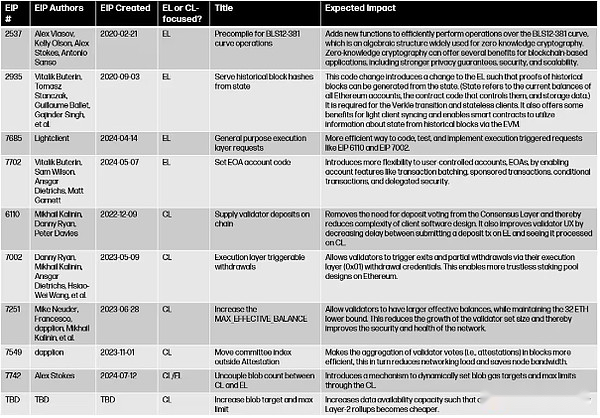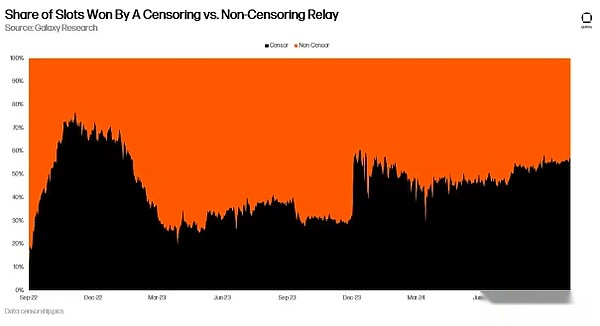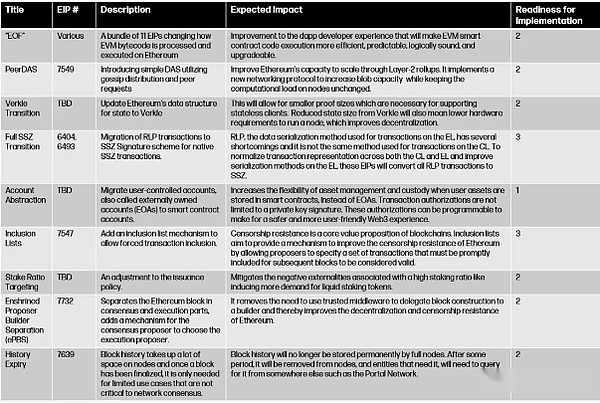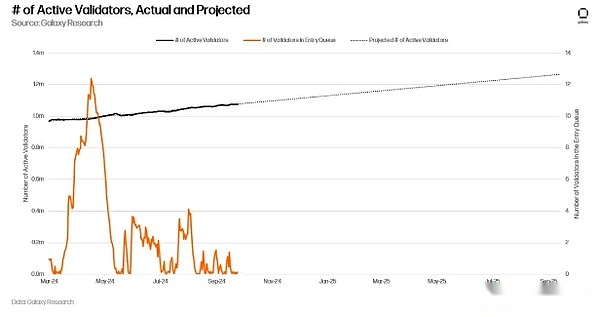
Author: Christine Kim, Galaxy; Compilation: Baishui, Bitchain Vision
Preface
In this report, we will outline the Pectra upgrade and its expected schedule for mainnet activation as of October, as well as validators, ETH holders and investors.at last,The report shares insights on protocol development in parallel with Pectra, such as historical expiration, built-in proposer builder separation (ePBS), and verkle tree migration.
How it starts
Prague-Electra, referred to as “Pectra”, is the name of the next Ethereum upgrade.Aside from the name, all other details about the upgrade have been changing since the developers started planning back in November.However, when discussing what is included in Pectra, it is clear that developers should agree on issues beyond the Verkle transition that the first priority of the Ethereum protocol should be agreed upon.Developers agree that the Verkle transition should be the focus of Pectra’s subsequent upgrades, but it’s unclear which code changes are prioritized before Verkle.
As a background, the Verkle transition is a major reform of the Ethereum state data structure.Status refers to the current balance of all Ethereum accounts, the contract code that controls them, and the storage of data.The developer plans to migrate all state data from the Merkle Patricia Tree structure to the Verkle structure.This will enable nodes to generate smaller proofs about state data and can be passed to other nodes more easily.In the future, developers imagine that nodes run by users do not have to maintain Ethereum state records, which are called “stateless clients”.These lightweight nodes that can run on resource-constrained devices will receive the necessary information to verify the block and rely on proofs generated by other nodes in the network that store state records, called “stateful clients” to advance the chain.本质上,Verkle 过渡旨在通过让用户更容易运行节点来改善以太坊的去中心化。
由于重构以太坊状态数据库的复杂性,开发人员同意将Pectra之后的下一次升级(称为Fulu-Osaka,简称“Fusaka”)专门留给Verkle。他们同意 Verkle 不会对协议进行其他重大更改,以最大限度地降低升级实施的技术风险。开发人员预计 Pectra 是一个小升级,他们可以轻松完成,然后再将全部注意力集中在实施 Verkle 过渡的更艰巨的任务上。
How is progressing
到 2024 年 8 月底,从以太坊改进提案 (EIP) 的数量来看,Pectra 将成为以太坊历史上最大规模的升级。The developers agreed to include 20 EIPs in Pectra and consider adding more EIPs to the list in early September.However, Pectra’s wide range has been the source of controversy and concerns among Ethereum developers and other stakeholders.Due to its scale, Pectra requires extensive testing and simulation to ensure that the planned 20 EIPs will not contain hidden bugs or vulnerabilities, especially when implemented in series.
As early as May 2024, a team of EthPandaOps, an Ethereum Foundation engineer who is responsible for organizing Ethereum upgrade testing, shared a blog post, suggesting that Pectra upgrades be divided into two.At the time, the idea was not seriously considered due to concerns that this might delay the Verkle transition planned for Pectra activation.Ethereum Foundation Fellow Alex Stokes once again proposed the idea on the All Core Developers Execution call #196 in early September.This time, the developers agreed more with the idea and insisted that doing so would allow them to deliver the first part of the upgrade within six months.
Therefore, all EIPs included in Pectra are planned to be implemented on two hard forks, not one.The scope of the first hard fork will include 8 of the 20 EIPs in the Pectra list.For the other 12 EIPs on the list, developers will continue to develop them in parallel to enable them on the mainnet after the initial 8 EIPs.
Pectra Overview
As of October 2024, developers have agreed to expand the scope of Pectra to include an additional code change, namely EIP 7742.Incorporating this code change in Pectra makes it possible for developers to increase blob capacity in Pectra as well.There are now nine EIPs.The Pectra upgrade is tentatively scheduled to activate the mainnet in early 2025 and may include the following 10 code changes:

Overall, Pectra includes a series of updates to Ethereum, which is expected to achieve three results:
-
Fixed a key flaw in protocols as proof-of-stake blockchain
-
Improve user experience with smart contract applications on Ethereum (UX)
-
Improve Ethereum’s data availability capabilities
On the surface, user experience improvements and Ethereum’s improvements as the DA layer are designed to encourage end users to no longer interact with smart contracts on Ethereum, but instead interact with smart contracts on rollup in a cheaper way.However, improvements to Ethereum user experience may have a “trickle-drop effect”, meaning that due to their implementation on the mainnet, they are likely to be adopted by Rollup, thus benefiting both Rollup and Ethereum’s end users.
It is worth noting that Pectra has not made any code changes designed to reinforce the narrative of ETH as a “solid currency” or a means of store of value.Furthermore, no EIP can directly improve the quality of Ethereum as a censorship-resistant blockchain, and since the merger upgrade, this problem has become a priority for developers to solve because of the known regulated entities involved in the block construction process.The number has increased.
More than 50% of blocks on Ethereum are generated by OFAC-compliant relays, meaning that the entity responsible for creating these blocks deliberately excludes transactions that interact with Ethereum addresses listed in the U.S. market.

Developers are working on code changes to reduce ETH releases and increase censorship resistance in future upgrades.However, they are not the focus of Pectra.
Fusaka Overview
The next upgrade after Pectra is Fusaka.Since developers have not finalized the upgrade scope, it is difficult to estimate Fusaka’s timeline.Currently, developers are keen to prioritize the 12 other code changes in Fusaka’s original Pectra EIP set, namely EOF code changes and PeerDAS.However, after the Pectra upgrade is complete, developers will reevaluate the EIP based on Fusaka’s priorities and readiness.
For reference, 12 code changes are listed below, which were originally included in Pectra but have been removed from the upgrade.

Note that except for the first EIP, the other 11 EIPs are code changes that change every aspect of the Ethereum Virtual Machine (EVM).These EVM-centric code changes together implement the “EVM Target Format” or EOF for short.EOF has made significant changes to the way EVM builds and processes code and is expected to improve the experience of smart contract developers by making smart contract code execution more predictable, secure and cost-effective.
In addition to PeerDAS and EOF, here is a list of all potential code changes that can be considered for Fusaka as of October 2024:

All the initiatives listed above have been discussed as potential candidates for Pectra upgrades, except for account abstraction and Verkle, but were not included in the upgrade due to lack of consensus on code changes.For many of these initiatives, a lot of research is still required before their designs are ready to be implemented.The last column in the table above arranges the degree of readiness for the above code changes from 1 to 3, where 3 are ready for immediate implementation and 1 is in the early stages of R&D.
在上述举措中,纳入清单和 SSZ 过渡是最成熟的。Of all parallel initiatives, account abstraction is by far the least likely to be prepared for Fusaka, as the path to implementing full account abstraction on Ethereum is still unclear, and many parts of this roadmap will be subject to EIP 7702 in PectraInfluence.
Given the uncertainty associated with these parallel initiatives, it is currently useless to assess their impact on the mainnet readiness or on the value of ETH.However, by 2025, a series of 10 code changes are likely to affect Ethereum stakeholders.
The next section of this report will explain in more detail the expected impact of EIP in Pectra on network stakeholders and ETH value.
Critical and non-critical repairs
There is an EIP in Pectra that is crucial for Ethereum to operate as a proof-of-stake blockchain.EIP 7251 increases the maximum valid balance of the verifier from 32 ETH to 2048 ETH and allows existing verifiers with a maximum valid balance of 32 ETH to consolidate their interests.This is expected to reduce the number of Ethereum validators, which has exceeded 1 million as of September 2024.
A simulation of Ethereum by Ethereum Foundation (EF) engineers showed that the protocol encountered serious network problems on 1.4 million validators.EIP 7251 is expected to alleviate network pressure by encouraging integration of staking ETH.To learn more about the problem with large validator set sizes,Please read this Galaxy Research report.
The basic principles behind 32 ETH validators
Beacon chains were initially designed for validators with a maximum effective balance of 32 ETH, as protocol developers wanted to encourage a large number of participants to participate in the Proof of Stake Consensus Agreement.The developers conservatively estimate that at 32 ETH, the beacon chain will attract approximately 312,500 validators, whose aggregated cryptographic signatures generated by these validators will be sufficient to protect the security of the nascent chain.
ETH was priced at about $600 when the beacon chain went live in December 2020, meaning users with less than $20,000 can run their own validators and earn Stake rewards independently.At that time, the pledge reward did not include the reward of transaction fees or MEV, and since the user was unable to withdraw funds, the pledge posed considerable risks.
In addition to encouraging participation, the valid balance of 32 ETH was chosen because the original design of the extended beacon chain through a “shard” requires each validator to maintain the same valid balance.If all users need to maintain a stake balance above 32 ETH, developers are worried that there are not enough validators to protect the chain.If all users keep the stake balance below 32 ETH, people will worry about the excessive number of validators, which will put unnecessary burden on the Ethereum network layer.
In addition to the maximum effective balance of 32 ETH, the developers set a large number of other constants and parameters in the protocol based on a rough estimate of future staking requirements for Ethereum.If the developers’ estimates are very inaccurate, they think that the chain’s economy and staking parameters can be adjusted through subsequent hard forks.Today, the rapid adoption of liquid staking solutions such as Lido and Coinbase has sparked discussions among developers to reduce the issuance curve of Ethereum.
Finally, there may be false assumptions about the true capacity of the Ethereum network layer.Ethereum founder Vitalik Buterin wrote in a 2021 blog post that the design specifications of beacon chains can effectively support the overhead of 4.1 million validators, or pledge the entire ETH supply, with a maximum effective balance of 32 ETH.In fact, due to various upgrades and changes implemented by the client, Ethereum’s network layer is unlikely to support 1.4 million validators, let alone more than 4 million.
Implementation details of EIP 7251
EIP 7251 is a complex code change that needs to be implemented.It fundamentally changes the way protocols calculate validator rewards, penalties, and withdrawals.The protocol does not perform these calculations based on the number of active validators, but rather on the combined valid balance of validators, each validator may vary from at least 32 ETH to 2048 ETH.
Especially in the process of changing the relevant cut penalty, developers have discovered an edge case where validators with smaller valid balances are disproportionately punished compared to those with larger valid balances.This edge case has been resolved during the Pectra testing process.As of October 2024, developers are still identifying bugs in the EIP 7251 specification and working on resolving them.
In addition to updating the calculations, EIP has introduced new actions for validators to integrate existing validators and downwardly adjust the initial cut penalty for validators with larger valid balances to encourage integration.
Once activated, it is unclear how quickly large staking entities can integrate their validators and reduce network pressure.There is concern that any peak in validator set size from now until the validator integration takes effect may negatively affect network health and network participants running validators in low-level hardware or where Internet bandwidth is limited.
The following figure shows the growth in the number of active validators since the Dencun upgrade.Dencun upgrade refers to the reduction of the maximum number of each epoch validator entry on Ethereum from 15 to a constant value of 8.The following figure provides a forecast churn rate for Ethereum validator set growth, down to 8 based on the activity of new validator entries since the validator.It is worth noting that the following predictions are conservative and do not consider the potential future staking demand catalysts, such as the maturity of restaking agreements such as Eigenlayer on Ethereum.

Non-critical fixes
In addition to EIP 7251, there are some non-critical fixes and improvements to be activated in the Pectra upgrade.They include:
-
EIP 7549, Move the committee index outside the proof– To make the CL client software more efficient, this code change introduces a refactoring of the verifier proof message.It is expected to reduce network load on validator nodes, albeit in a less than EIP 7251.
-
EIP 6110, providing validator deposits on the chain– This code change will transfer the responsibility for verifying the new staked ETH deposit from CL to EL.In doing so, developers can improve the security of deposits, reduce protocol complexity for CL clients, and improve the staking user experience by reducing latency between depositing 32 ETH on EL and new activation validators on CL.
-
EIP 2935, providing historical block hash value from state– Changes to EL were introduced so that proofs of historical blocks can be generated from state.It may provide some additional features for smart contract developers as they will be able to access information about Ethereum’s state from previous blocks.Mainly, this is a necessary code change to prepare for the Verkle transition.
-
EIP 7685, General Execution Layer Request– Create a common framework for storing requests to CLs triggered by smart contracts.As smart contract-based staking pools become increasingly popular, smart contracts need to be directly exposed to validator withdrawals (EIP 7002) and mergers (EIP 7251) on CLs.This code change introduces a protocol framework to store these types of requests for easy handling by CLs.
Expected impact
The critical and non-critical fixes activated in Pectra will primarily affect validator node operators, who will have to update their operations to take advantage of the higher effective balance of EIP 7251, the efficiency improvements of EIP 7549, and the tiny user experience improvements of EIP 6110.The former will benefit node operators in future upgrades, when stateless clients will become a reality, while the latter will improve the implementation of code changes such as EIP 7251, but will not improve the status quo of the network in other ways.
End users and ETH holders are not expected to benefit directly from these five code changes.These code changes are primarily conducive to the health and resilience of Ethereum as a proof-of-stake blockchain.In the long run, they are positive about the value of the agreement because they ensure that the agreement continues to operate safely and smoothly.However, they do not introduce new features that substantially improve the user experience of end users, smart contract developers, or aggregated.Therefore, they are not expected to have an excessive impact on the value of ETH.
Like any network-wide upgrade on Ethereum, volatility in ETH may intensify around Pectra, and if any unexpected errors or failures associated with the upgrade occur, the price may fluctuate negatively.It should be clear that given that these code changes have undergone a lot of combat tests before activation in case of interference with the mainnet causing interference to the network, the possibility of Pectra’s upgrade is slim.Therefore, unless ETH temporarily fluctuates before and shortly after the upgrade, code changes in Pectra related to various parts of the repair protocol are not expected to have a long-term positive or negative impact on the value of ETH.
Affected stakeholders:Verify node operator
Expected impact on ETH:neutral
User experience improvement
There are three EIPs in Pectra that will introduce user experience improvements to Ethereum’s end users and smart contract developers.While pursuing a summary-centric roadmap, developers are also working together to improve Ethereum’s value proposition as a leading general-purpose blockchain.
EIP 2537, BLS12-381 Precompilation of curve operations –Add new functions to efficiently perform operations on the BLS12-381 curve, an algebraic structure widely used in zero-knowledge encryption.Zero-knowledge cryptography can provide multiple benefits for blockchain-based applications, including stronger privacy assurance, security, and scalability.The ability to perform operations on the BLS curve will benefit applications and aggregations built on Ethereum that have already used zero-knowledge proof systems or are seeking to integrate such systems into their operations.
EIP 7002, execution layer can trigger withdrawals –EIP 7002 creates a stateful precompilation, a mechanism for modifying the EVM state for validator withdrawals.Currently, the verifier on the beacon chain can only exit through intervention by the verifier’s withdrawal key owner (usually the operator of the verifier).EIP 7002 introduces a smart contract mechanism that can own validator withdrawal credentials and use them to trigger validator exit without manual intervention from the validator operator.It will provide more trustless designs for staking applications and enable existing staking applications to eliminate the assumptions of trust for honest behaviors of their validator node operators and the security of these applications.
EIP 7702, set up EOA account code –Create new transaction types for end users to add short-term features to their user-controlled Ethereum accounts, such as:
-
Transaction batch processing, authorize multiple on-chain operations by signing a single transaction
-
Sponsorship, pay transaction fees on behalf of another account
-
Degraded permissions, specific expenditure conditions for authorized account balances
Given that most users perform transactions on Ethereum through wallet providers, wallet developers will need to take advantage of new transaction types and add these features to their designs in a way that users can easily access.
Expected impact
Unlike critical and non-critical fixes, these code changes will enable more complete application development directly on Ethereum.EIPs such as 7002, 2537 and 7702 will respectively realize more trustless staking pool design, privacy-enhanced decentralized financial protocols, and secure user-controlled accounts.
Affected stakeholders:End users, smart contract developers
Expected impact on ETH:positive
DA Improvements
As mentioned earlier in this report, another code change may be included in Pectra.Developers are considering a small increase in the blob Gas target to improve the scalability of Ethereum as the data availability (DA) layer.There are many larger and more complex code changes related to improving DA capabilities with EIP 7594 (PeerDAS).However, since EIP 7549 will no longer be activated in Pectra, it was suggested that simpler changes be introduced to reduce DA costs.
Currently, Ethereum can handle up to 6 blobs per block and dynamically adjust the cost of these blobs to average the target of 3 blobs per block.The suggestion made by Francis Li, a developer of Layer-2 rollup Base, is to increase the number of blob targets per block to 5 and the maximum number of blobs per block to 8.
In Li’s proposal, he pointed out that even conservatively increasing the target blob count to 4 instead of 3 will help build the Rollup team on Ethereum.Developers support Pectra’s increase in blob targets to a large extent.However, the confirmation of this view and the formal inclusion of DA improvements in Pectra remains to be decided on a future ACD conference call.Currently, developers have agreed to include EIP 7742 in Pectra, which will pave the way for changing Ethereum’s blob capacity by tuning CL.
-
EIP 7742, Decoupled blob counts between CL and EL – Maximum and target blob limits are constantly hard-coded on EL and CL.EIP 7742 enables CL to dynamically adjust the maximum and target blob limits so that future changes to DA capacity do not require hard forking the two layers, but can be specifically adjusted through CL.
In addition to the increase in EIP 7742 and blob capacity, developers are weighing two additional code changes related to optimizing the Ethereum DA functionality in Pectra or Fusaka:
-
EIP 7762, add MIN_BASE_FEE_PER_BLOB_GAS– When the demand for a blob exceeds the target rate (currently 3 blobs per block), the protocol automatically adjusts the mandatory base cost of the blob.EIP 7762 adjusts the minimum base cost of blobs higher so that the Blob fee market can be more sensitive to fluctuations in Blob demand and enables Blob price discovery faster.
-
EIP 7623, increase the cost of calling data– In addition to blobs, summaries can also publish arbitrary data to Ethereum using the transaction’s call data field.However, calling data fields that utilize transactions are generally more costly for summary.EIP 7623 is designed to further increase the cost of calling data to reduce the maximum size of the Ethereum block.As Ethereum developers increase block size by increasing blob capacity, they want to prevent edge cases where validators with large amounts of call data and a maximum number of blobs propagate exceptionally large blocks.
Increasing blob throughput in Pectra is a controversial topic among developers, as this may reduce the number of independent stakeholders running on the network, thereby negatively affecting Ethereum’s decentralization.A separate staker is a user who stakes his own ETH and runs his own stake operations at home or through a cloud provider, rather than relying on a stake pool or other intermediary service for stake.Independent stakers are users who operate validators on the most resource-constrained devices compared to other types of stakers.
Increased blob throughput may increase the computational requirements of operating validators, causing some individual stakeholders to shut down their machines.On ACDE #197, developers shared some anecdotal evidence that some individual stakers are already working hard to operate the Dencun validator.Developers have agreed to conduct a data-driven study on the health of individual staking operations before deciding to increase Pectra’s blob capacity.
Expected impact
In the short term, Ethereum’s DA improvements are expected to reduce protocol revenue from Layer-2 rollups (L2), increase profit margins for L2 sorters, and reduce transaction fees for L2 end users.These effects are expected to be similar to those that occur after activation of EIP 4844 in the Dencun upgrade.
Affected stakeholders:2-layer summary, L2 end user, ETH holder
Expected impact on ETH:Negative
Pectra Timeline Analysis
The developers have discussed two alternative code changes to include them in Pectra in case changes to the blob fee market end up not being included in the upgrade.Since the blob capacity in Pectra may increase, these two code changes are unlikely to be included in Pectra.They are EIP 7782 and
EIP 7782 proposed by Nethermind developer Ben Adams reduces the Ethereum slot time from 12 seconds to 8 seconds.This change in slot time will effectively increase Ethereum’s transaction throughput by 50% and reduce transaction confirmation speed by 33%.The concerns raised by developers about the proposal on ACDE #198 and ACDC #144 is that it may accelerate state growth rates, making the Verkle transition even more difficult.Additionally, Ethereum Foundation researcher Francesco D’Amato said changes in time periods may negatively impact positive research initiatives, such as built-in proposal builder separation (ePBS) and inclusion list (IL).
EIP 7783 was proposed by Eragon developer Giulio Rebuffo and is a relatively easier code change for developers because it does not require a hard fork.EIP 7783 creates a mechanism for client teams to gradually increase Gas goals over time.Increasing the Gas target will increase the maximum number of transactions that can be included in a block.Rebuffo’s proposal does not specify a specific Gas target, but simply suggests a mechanism for developers to select targets and gradually safely increase them to this threshold.During a recent October 2024 call, developers discussed the potential of implementing EIP 7783 shortly after the Pectra upgrade.
Adding any new EIP in Pectra may delay activation of the mainnet upgrade.Additionally, the longer the developer delays in deciding the final range of Pectra, the longer the developer upgrades to the public Ethereum testnet.As of October 2024, it seems that developers are not close to the scope of finalizing Pectra.Therefore, it is unlikely that Pectra’s public testnet upgrade will be launched by the end of this year.
Assuming that the scope of Pectra is finalized in January or early February next year, developers will need to test any new additions to Pectra on a private test network (also known as a development network) before continuing to upgrade the public Ethereum test network.Set aside at least one month’s budget to test other code changes for Pectra, and it is recommended that developers can start a public testnet upgrade in March to temporarily activate the mainnet upgrade sometime in April or May.

These schedule estimates may change based on how long the developers will finalize the Pectra range in the coming months and the complexity of the code changes they decide to eventually add to the upgrade.
Other catalysts for ETH value
So far, Pectra is a hybrid code change, some of which are expected to enhance the experience for users and smart contract developers.As Pectra’s scope is simplified, the upgrade is not expected to have much impact on ETH value.In addition to Pectra, Ethereum has more subsequent updates that may affect ETH value more directly, such as reducing the issuance and implementation of PeerDAS.However, as mentioned earlier in this report, it is difficult to predict when these changes will be activated on the mainnet.
It is worth noting that as Ethereum further pursues scalability improvements in DA based on the “summary-centric roadmap”, the impact of protocol upgrades on Ethereum on ETH value should become smaller and smaller over time..In the long run, Ethereum revenue may be driven primarily by user activity on L2 as applications and users migrate to L2.Upgrades occurring on L2 can improve user experience, interoperability, decentralization and security on these networks, which is more important to Ethereum’s value than the optimization and improvement of the underlying layer.While upgrades like Pectra will further enhance the decentralization and availability of protocols, they are unlikely to attract a new wave of users and drive adoption of decentralized applications, as Rollups can scale to meet this demand, while EthereumThen not.Therefore, applications built on Rollup and protocol upgrades based on Rollup (further enhance the functionality of applications built on Rollup) are key to analysis when evaluating the factors driving the value of ETH.
A common resistance to the Rollup-centric roadmap is the concern that Ethereum may become too cheap because of the DA tier, or that revenue from Rollup is too small to support the value of ETH.These arguments underestimate the overall potential market for decentralized applications.Currently, cryptocurrency use cases are disrupting every industry in the world, as public blockchains have the potential to fundamentally change human coordinated activities, just as artificial intelligence (AI) has the potential to disrupt all industries. This technology has fundamentally changed allHow to generate digital content in the industry.
Although scalability improvements such as EIP 4844 or PeerDAS will reduce protocol revenue in the short term.They are laying the foundation for Ethereum to support more on-chain activity than on Ethereum L1.Gaming, fundraising, decentralized finance and social media are just a few examples of the types of applications that have historically caused a surge in Ethereum transaction volume and fees.These applications take advantage of Ethereum’s network effects, decentralization, censorship resistance and composability.In theory, in addition to significantly reduced fees and enhanced features such as different types of virtual machines, programming languages, and account management, applications on the aggregate will be able to take advantage of all these benefits on Ethereum.
However, in practice, summaries do not meaningfully inherit the properties of Ethereum such as decentralization, censorship resistance or composability.Although they can effectively reduce transaction fees, they come at the expense of decentralization and security.In other words, aggregation does not scale Ethereum in a meaningful way other than reducing transaction costs.There are too many trade-offs that users need to migrate their activities and applications from L1 to L2.Infrastructure projects like Rollup like other scaling solutions developed on alternative Layer 1 blockchains and restaking solutions and ZKVM are underway.Until Rollup is mature as a technology and benefits from the decentralized nature of Ethereum, pure DA improvements may not drive a new wave of adoption of Ethereum or Rollup built on it.
in conclusion
Despite uncertainty in the scope and timeline of Pectra, Ethereum is still the leader in the Web 3 era. In the Web 3 era, human coordination mainly uses decentralized blockchain technology rather than centralized Internet protocols.conduct.To achieve this, Ethereum must continue to expand as a decentralized technology while fighting centralized forces such as Maximum Extractable Value (MEV) and transaction censorship.While Ethereum certainly has competitors in realizing this vision, dominance in the Web 3 blockchain space remains a must-have game for Ethereum.
Ethereum continues to maintain the highest network effect of all general blockchains.For smart contract developers, it remains the most tried and tested blockchain, and the most studied blockchain among researchers and developers, used to solve related to scaling, MEV, censorship, user experience and morechallenge.However, as Ethereum developers pursue a Rollup-centric roadmap, the importance of Ethereum as a technology and Ethereum upgrade should diminish, as the solution to the biggest problem facing Web 3 will be inherited by Rollup.
Pectra will introduce user experience-centric code changes that are expected to attract new users and smart contract developers into the Web 3 space.However, this may be one of the last few remaining upgrades, with code changes on the protocol directly affecting users and ETH holders.As users migrate to Rollup, protocol revenue is increasingly driven by Rollup activity, and the most important code change for Ethereum stakeholders will be the code changes made on Rollup.To this end, it is important to analyze the maturity of Rollup as a technology and its ability to meaningfully inherit Ethereum security and extend it to millions of new users.








